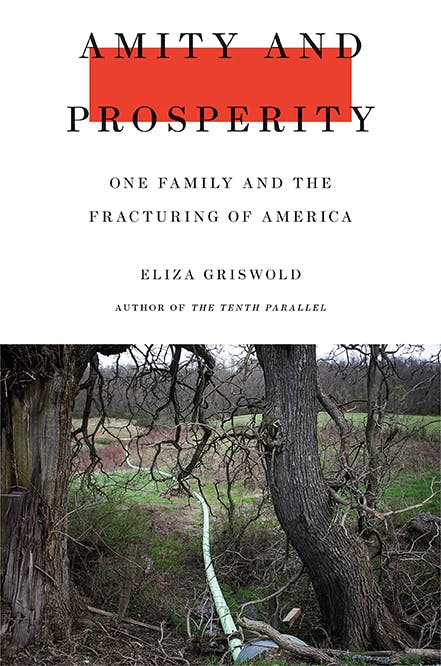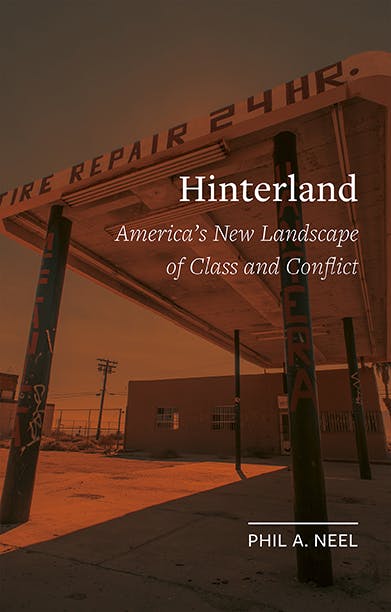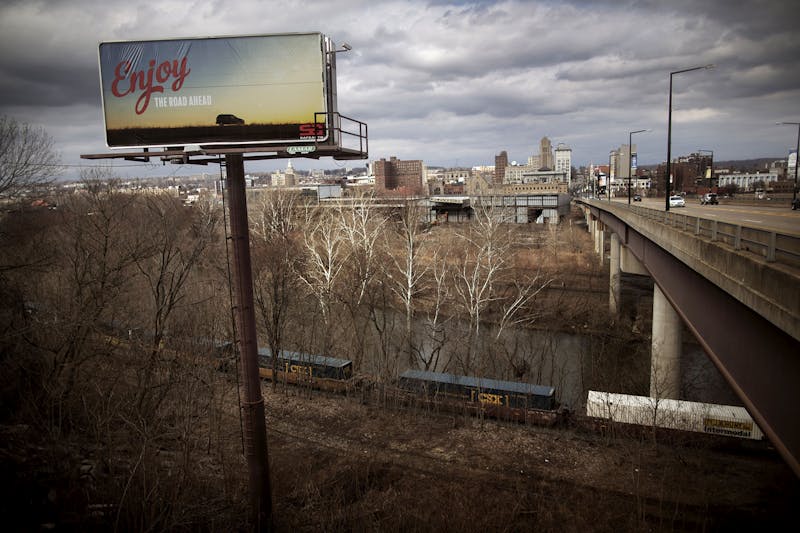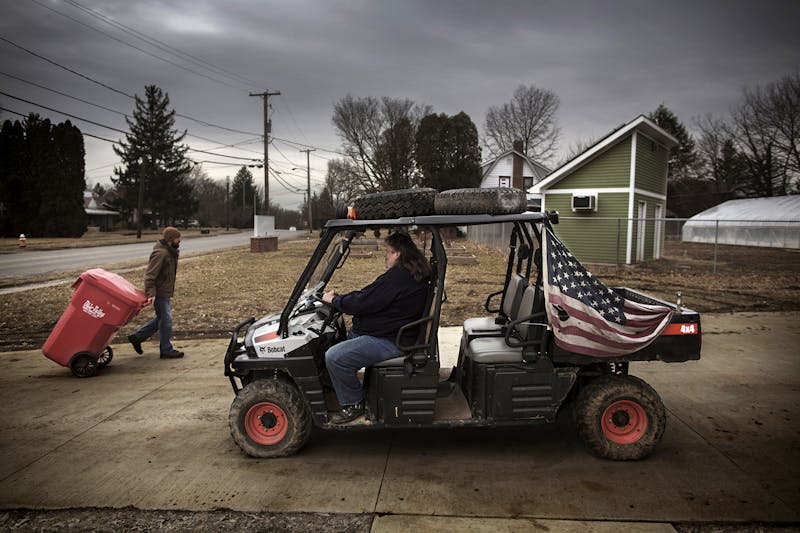What do we talk about when we talk about class? Is it economic or is it cultural? Is it the working poverty of a nurse and single mother in Washington County, Pennsylvania, whose household is poisoned and small homestead ruined by fracking? Or is it the identity politics of a white Wisconsinite flying a Confederate flag from his pickup truck a short drive from the Canadian border? Is class an open wound in American life, evident in Bernie Sanders’s denunciations of “the billionaire class” and Donald Trump’s images of “American carnage,” or is it the country’s secret shame, constantly shuffled aside with reassurances that poor Americans are simply “temporarily embarrassed millionaires,” as John Steinbeck put it?
For Karl Marx, whose 200th birthday passed this year, class named a person’s role in the way a society wrests its living from the earth and divides the value. Class described the difference between a sharecropper and a plantation owner, between the enslaved person being worked to death in a Caribbean sugar field and an investor living in London on dividends from the sugar trade. It was the only nonarbitrary way to begin a description of human life, because we are our bodies, productive and need-ridden. As God told Adam and Eve, and as John Smith reminded the starving colonists at Jamestown, those who do not work do not eat. By the same token, those who do not find some stand-in to work for them—a machine, a draft animal, or another person—do not get much chance to rest, play, or learn. So to understand any group of people, you must know who does the work and who gets the goods. You can expect that a great deal of politics, law, culture, and religion will be shaped in response to these material patterns—sometimes against them but more often in an attempt to give them the appearance of inevitability and justice.
Marx’s emphasis on class was not exactly new. Adam Smith wrote that government was “instituted for the defense of the rich against the poor.” Much of his intricate social psychology concerned how wealth and power attract esteem, while “the poor man goes out and comes in unheeded.” John Stuart Mill devoted chapters of Principles of Political Economy to the class structure of the modern economy and its premodern predecessors and observed that “all privileged and powerful classes, as such, have used their power in the interest of their own selfishness.” He even argued that, if the market economy continued to give the wealthy who did no work “the largest portions,” while those who performed “the most fatiguing and exhausting bodily labour” struggled to get by, then the right thing could only be to try communism instead. The philosophical fonts of modern theories of the self-regulating market and the self-defining personality, Smith and Mill found it impossible to talk about collective life without putting class at its center.
A decade ago, there was little discussion of class in the mainstream of American politics or culture, except as anathema when some hapless redistributionist was accused of “class warfare.” Then the 2008 financial crisis showed the fault lines in a superficially prosperous economy, Occupy Wall Street crystallized the diffuse class consciousness of “the 99 percent,” and Thomas Piketty’s Capital in the 21st Century spread the word that humanity is divided into the many who are treading water, the few who are getting more comfortable, and the very few whose household budgets might as well be midsize university endowments or midsize national economies. In 2016, the two presidential campaigns that became movements, Donald Trump’s and Bernie Sanders’s, both rallied popular indignation against elite control. Class is back, but its meanings range from anti-oligarchy to racially coded just-folks nationalism, and it is cross-cut by race, gender, and migration in ways that earlier generations found much too easy to minimize. Long a silent presence in American life, class has lately raised a cacophony.
Three new books go beyond recent assumptions about class in America and attempt to grasp a new situation. Phil Neel, a graduate student at the University of Washington, draws attention to the geography of class in Hinterland, identifying both a new working class and the global forces that have shaped it. Eliza Griswold’s Amity and Prosperity (deftly named for two side-by-side towns with little of either) meanwhile emphasizes lived experience, as she closely depicts the lives of the rural Western Pennsylvanians whom she visited off and on for seven years as they were worn down by fracking pollution and the grind of working poverty. To these reports Steve Fraser, a labor historian and product of 1950s suburbia and 1960s radicalism, brings a longer perspective. In Class Matters he traces Americans’ reluctance to talk in terms of class and tendency instead to favor the myth of “the pristine free individual.” This long history of what one might call class denialism is an essential complement to Neel’s and Griswold’s portraits of the present and future of class identity and experience. Understanding class today means taking in its material, emotional, and ideological reality at scales that are both global and intimate, historical and immediate.
It would be easy for Neel to claim to be an authority on class in rural America on the strength of his own upbringing, as authors such as J.D. Vance have done. In 2016’s Hillbilly Elegy and subsequent writing, Vance built his interpretation of Appalachia, the Rust Belt, and the Trump era on a sensitive but blinkered portrait of his own family’s strengths and wounds. Neel deliberately avoids this strategy: Although he grew up in a trailer in the Siskiyou Mountains, in the marijuana country of California’s far north, there is no family narrative in his book, not even enough to sort out whether his parents were hippie back-to-the-landers, survivalists, loggers, weed farmers, or American Buddhists—or, perhaps more accurately, in what respects they were part of each culture, as they overlap and mingle in that particular hinterland (as milder versions of them do in the Appalachian hinterland where I grew up a decade ahead of Neel).


Instead of describing a sense of class that is anchored in a specific region, Neel emphasizes that upheavals and dislocation connect working-class experience across regions and continents. Like the other commodities of global capitalism, wage laborers are often defined less by any place they call home than by their patterns of movement. They are drawn from the land in one place, run through factories in another, and processed in the massive logistics hubs of ports, rails, trucking networks, and warehouses. Neel’s book opens on a train in Southern China, where he is surrounded by migrant workers moving among home villages and factory towns. He later recounts experiences on work crews in Nevada; in jail or prison somewhere unspecified; looking for a job near the Seattle-Tacoma airport; and at the riots in Ferguson, Missouri, in 2014. In each spot, it’s clear he has recently arrived from somewhere else. He doesn’t draw his lessons from origins in a working-class place but from passing through the global patterns of working-class life.

The hinterlands of Neel’s title are defined by these patterns of capital-dictated movement. Hinterlands are the invisible but indispensable logistics hubs where the shitty but abundant jobs are, and, even more centrally, the increasingly abandoned countryside of extraction and primary commodity production where jobs in farming, mining, and logging are being lost to automation, and not much has shown up to replace them. These are the little towns where militias crop up, the places that went 60 and 70 and 80 percent for Trump. There are such landscapes everywhere, Neel argues, because production, extraction, and other work everywhere reflect the same globally integrated logics. The same warehouses and heavily mechanized factories spring up in depopulated fields and forests, and little towns are emptied of working-age people, leaving the same desolate hinterlands. You wouldn’t come to understand all this by virtue of being raised in the Siskiyou range, but you might understand because you, too, have been hurled and tugged across the landscape like a low-margin commodity seeking a buyer.
Neel suggests that in these places new classes are being born. There are the people who do the logistics work, taking orders from algorithms to keep global markets humming, while exercising no real initiative and having little concrete human interaction. Then there are the people who have not even been able to get jobs in this economy—left-behind people in left-behind places, getting by on the peripheries of the deep hinterland. Neel is particularly interested in the political future of these places. This leads him to some provocative reflections on race. At the same time that “whiteness” is being elevated as an identity on the alt-right and interrogated on the progressive left, its material reality is increasingly fragmented. The predominantly white professional and “upper-middle” classes thrive, while statistics show rural and blue-collar whites slipping toward unemployment, imprisonment, and early death. Neel hastens to emphasize that these fates still disproportionately haunt African Americans, Native Americans, and Latinos; but given the depth of racial inequality in the United States, it surely reveals an important shift in lines of vulnerability that, in at least 30 counties in the South, middle-aged white women are dying faster than black women of the same age. Even as race and racism become more salient in national politics, the disregarded and discarded classes are a composite of the downwardly mobile and the long-trapped, who often remain scared of one another despite an increasingly shared relation to the economy that makes their lives.
At the same time, ironically, a Southern-inflected “country” culture has become the standard fare of white Trump voters, who are mostly exurban and middle-class but are drawn to the touchy toughness of the big truck, the rifle, and the swagger. Indeed, “country” style generally, a form of distinctly white identity that spans the exurbs and rural places, is a weird mix of Western kitsch and Southern threat—cowboy boots and Confederate flags in the northern Midwest and Western New York, places once better known for radical miners’ unions and abolitionism. Neel asserts that “traditional methods of transforming class antagonism into racial difference are beginning to reach a sort of saturation point,” but this halfway optimism seems unlikely: Trump’s predecessors have created even more animus in the past.
Neel doesn’t propose to solve any current “What’s up in Trump country?” debates. Instead he sets out to show the transformation, and often enough the hollowing out, of large tracts of twentieth-century life as the product of global capitalism. Hinterland is hectic and unsystematic but often tonic, not least because few people who think this way have seen most of the places Neel has, let alone from the standpoints he has sometimes occupied—rioter, prisoner, day laborer. He is less convincing in the lessons he draws. His touchstone for thinking about politics is the riot, which he presents as the incipient form of a new mode of cooperation in which the dispossessed threaten to break and reappropriate the supply lines of global capitalism. He is fascinated by right-wing militias, such as the border-patrolling Oath Keepers and the Three Percenters, because he thinks that, stripped of racism and nationalism, street-fighting vanguards can liberate territory and populations for a different oath: “fidelity to [the] destruction” of the same global capitalism that is creating and dispossessing the hinterlands.

“I don’t know what’s coming, even though I know something is rolling toward us in the darkness,” Neel concludes. “Whatever’s coming has no name, and anyone who says they hear it is a liar. All I hear are guns cocking over trap snares unrolling to infinity.” This blending of gnomic pronouncements with macho intimations of violence—a little Heidegger, a little more Hunter S. Thompson—is the weakness in Neel’s thinking and in his prose.
The thought that riots would be revolutionary—not against some weak backwater state but against a global order of production and exchange—has it backward. Institutions such as the state, with its sustained power to quash or remake markets, are the historically unique political resource of our time. That is why everyone with much at stake in global capitalism, from the Trump family to Silicon Valley, cares very much who controls the state. A revolution, after all, is not just an insurrection but an alternative mode of order that replaces the previous one. The conceit that a riot could prefigure such a mode of order is much less plausible than a grimmer and very different forecast that Neel makes: In the new hinterlands, “political support will tend to follow whomever can offer the greatest semblance of strength and stability.” Self-styled communist rioters are likely to lose that contest to right-wing strongmen of the Trump variety. But anti-racist social democrats just might have a chance of winning it—after all, Bernie Sanders won the Democratic primaries in many hinterland regions, such as West Virginia and the Great Plains, by running against corporations and for social protection.
Indeed, self-styled democratic socialists recently won several Democratic primaries in state legislative races around Washington County, Pennsylvania, where Eliza Griswold spent parts of seven years during a massive fracking boom. Her time there brought her close to a world that is both like and unlike what Neel describes. Neel mostly explores male labor and masculine responses to the crises of the hinterlands; Griswold attends mainly to women and children. Neel is not much interested in characters or narratives; Griswold weaves Amity and Prosperity around the stories of Stacey Haney, a nurse and divorced mother of two, and her sister, Shelly, for most of the book a single mother. Stacey is an anti-fracking activist by accident. Her political work emerges from years of frustration trying to persuade state and federal regulators and Range Resources, the local fracking behemoth, to acknowledge and do something about the slow poisoning of her family by fracking contamination.
Washington County lies southwest of Pittsburgh, at the border of Appalachia and the Midwest. Many of the people there trace their history to the late eighteenth century and the American Revolution, which saw exceptionally bloody and sadistic fighting between Anglo settlers and regional tribes. Moving across the generations from one small farm to another along dirt and gravel roads, the local people sometimes look land-rich from coasts where professionals struggle to buy apartments, but they are persistently cash-poor in local economies where there has not been much work for years outside of public schools and hospitals.
Griswold’s characters have not been drawn into Neel’s global web of extraction and exchange, but in many ways their quietly stressed existence is a product of it. Their landscape is postindustrial with a fragmented bucolic overlay. Their water supply is often drained off or broken underground by decades of coal mining. The streams are sometimes dangerously polluted, thanks partly to a local entrepreneur who makes his money illegally dumping toxins. There were once steel jobs—Pittsburgh is not that far away—and the Haneys’ father, a Vietnam vet with PTSD who lost his mill job under Reagan, feels permanently betrayed by American geopolitics and industry. The fracking boom brings a new industrial army into Washington County—Texans, Oklahomans—and the young men in pickups bring the fights, prostitution, and drug use of all boom towns.
Griswold documents class without having to name it. Class is contaminated water, children with chronic pain and fatigue, and no money or extra time to address the fact that their grades are collapsing year by year. It is living downhill of the pond where fracking fluids are stored. It is being hurried through a signing session for a drilling lease on your small property, without a lawyer and without a chance to read documents written to confuse you. It is wondering whether you have time to meet with an environmental enforcement agent about your problems when the last one disappeared without communicating and every meeting means time away from your nursing job. It is lawyers and bureaucrats looking at their phones while they meet with you. It is a high-schooler adjusting his expectations from going to college to joining the Army to mowing lawns.
It is months of scrimping to keep up appearances at the 4-H livestock show, while your ailing son would rather smoke weed than promenade for the judges with his goat, and it is the mix of gratification and humiliation when the fracking company you are fighting buys the children’s animals at the subsequent auction—traditionally a compliment, but now also a way of saying they own you. It is wondering what God is trying to tell you when thieves—you assume they are junkies, because most property crimes near you are committed for drug money—strip the house you have abandoned because of contamination. In short, it is doing your very best, working hard and showing up, and learning that no one is paying attention, and that the world is not set up to reward you or even to make sense to you.
Griswold is scrupulous toward her subjects, frequently paraphrasing them on the meaning of their experience and drawing few conclusions of her own. She listens nonjudgmentally, setting out a forum for Stacey and her family to narrate their own lives. In this ethical posture, she unavoidably highlights the awkward decorum of interclass relations between a Princeton graduate and people living in a semi-industrial countryside on the edge of respectability—a nurse just holding her little household together, a former heroin addict living in his family’s junkyard, another single mother whose living room is organized around a disconnected Jacuzzi that she bought as scrap and uses to store clothing. Griswold memorializes their malapropisms (“arsenip” for arsenic, which may be poisoning them and their livestock) and spelling errors (“I hope you rott with cancer!!!” writes Stacey to the unknown criminals who strip and trash her house).
These passages made me cringe a little, not for Griswold, but because she had brought me so near the difficulty her book explores, the keen, ubiquitous American awareness of class and the ways it makes unforced expressions of respect and mutuality so difficult. A few of these sentences convey in miniature the dilemmas of tone that dogged the presidential campaigns of John Kerry and Hillary Clinton. There is no good way through it.
Class is everywhere, impossible to escape or even look away from, but it is still unusual for politicians or commentators to call it by name. In a class-ridden society, Americans often manage to dodge the issue. How? Steve Fraser blends memoir with historical essays that aim to explain the process by which class has often been erased in the telling of important episodes in American history: early English settlements, the erection of the Statue of Liberty, the cowboy era of the Western range, and the transition from the labor radicalism of the 1930s to the Civil Rights era.
It is a worthy endeavor, and sometimes illuminating. I learned that the French progenitors of the Statue of Liberty wanted it to symbolize a liberal, humanitarian politics, steering between right-wing reactionaries and the left-wing radicals of the Paris Commune, and that many of its American funders were small donors out to shame decadent Gilded Age robber barons who wouldn’t contribute to a civic monument. It is good, too, to be reminded of the odd transformation of the cowboy—the low-status proletarian of some two decades in which East Coast and European capital dominated the open range—into a symbol of American masculinity and independence.
In some ways, Fraser covers well-trodden ground, as his historical chapters trace a perennial fantasy that freedom could mean personal self-reliance rather than collective emancipation. Both the early English settlers and the American Revolutionaries lived in profoundly class-ridden societies, with downtrodden (and sometimes cruelly disciplined) servants and restive debtors and runaways, yet official American history identifies with the rulers of these hierarchical societies as if they were middle-class democrats. Abraham Lincoln argued in 1858 that (white) Americans had sidestepped the class divisions of the Old World, a fantasy that has shaped national memory for the majority of people today.
Fraser seems unclear on what gives the fantasy its power. At times he suggests that “the fear and denial about class indigenous to the American makeup” have worked “black magic” to, say, turn Cold War anti-communism into a McCarthyite crushing of the left-wing strains of labor, the black freedom struggle, and the left flank of the Democratic party. The purpose of Fraser’s capsule histories is to rise above this kind of generalization, in favor of more specific accounts of how class rose and fell in American politics and culture at one time or another. Without a more explicit theoretical apparatus, though, Fraser tends to default to the “indigenous to the American makeup” story. That, unfortunately, is just a paraphrase of noticing the suppression of class everywhere without really being able to say how it happens.
Fraser’s most vivid observation is a simple one: Although the Civil Rights movement’s official triumphs feel almost contemporary in official American iconography, serving as the images of the dawn of an age, the strikes and mass mobilization just a decade or two before might as well have happened in a different country. How did one American radicalism become the official common ancestry of the country’s mainstream, while the other disappeared down the collective memory hole? Fraser’s main explanation is Cold War anti-communism, which gave conservatives the chance to press radicals to the margins or persecute them outright. He thinks the conceit that American politics rests upon a consensus on freedom and equality—from the Declaration of Independence through the Gettysburg Address to the “I Have a Dream” speech—is itself a product of the Cold War search for a nonracist, nonreactionary, but also nonsocialist basis of national unity.
Even this, however, is a very broad brush. The Cold War period was rather multifarious in its “consensus” politics. Despite McCarthyism and more mainstream anti-leftism, the Johnson years struck many influential observer-participants, such as economist John Kenneth Galbraith and Senator Edmund Muskie, as the beginning of a social-democratic era of leisured prosperity in a newly inclusive country. By the 1980s, Cold War America was instead the union-busting, tax-slashing, mill-closing Reaganite twin to Margaret Thatcher’s neoliberal Britain. Cold War American elite governance could mean the Warren Court, which consolidated the desegregation of public institutions and established the one-person-one-vote principle, or the Supreme Court of the 1970s, which laid out the premises for Citizens United and a constitutional ban on affirmative action. The inch of difference between these two Cold War worlds has made all the difference in many lives.

One of the more suggestive documents of the transition from the halfway social democracy of the Cold War era to today’s mostly neoliberal order is a memo that Lewis Powell, soon to be a Nixon appointee to the Supreme Court, wrote in 1971 to Eugene Sydnor Jr., the head of the Chamber of Commerce. Powell warned of a “broad attack” on “the American Free Enterprise System,” and urged “businessmen to recognize that the ultimate issue may be survival.... If our system is to survive, top management must be equally concerned with protecting and preserving the system itself.” Powell urged a broad mobilization of business interests, from newly aggressive lobbying and litigation to campus speaker series. There should be “no hesitation to attack” the enemies of the free market, Powell insisted, nor “reluctance to penalize politically those who oppose it,” because what was at stake was not just profit or freedom to manage, but individual liberty itself. “Freedom as a concept is indivisible,” Powell wrote, echoing libertarian intellectuals such as Friedrich Hayek and Milton Friedman who spent the mid-twentieth century defining the defense of capitalism as the defense of freedom.
Each of these books—Neel’s, Griswold’s, and Fraser’s—honors the view from below or from the hinterland, where class is something that happens to you, like the weather but worse and more unrelenting. This emphasis has much to recommend it: ethically in its attention to lived experience, politically in its emphasis on concrete conflicts, intellectually in its alertness to variation and nuance. In one way or another, though, each book ends up a meditation on the opacity of class experience, to those who live in it but also to those who theorize it.
By contrast, there is nothing murky in the class-consciousness of the Powell memo. It suggests that there have always been many Americans for whom class is no mystery at all, but a very practical project of self-advancement and self-defense. There is nothing conspiratorial in this thought. It simply acknowledges the same class-conscious common sense that Powell’s memo expresses. Recent studies of the Koch brothers’ influence campaign, the construction of the conservative legal movement that produced most of the judges Donald Trump will put into lifetime positions on the federal courts, and the decades-long businessmen’s assault on the New Deal all tell the story of class consciousness from above. In some ways, the view from there is very clear. Maybe it is time for a study called, in ironic appreciation of the Marxist humanist historian E.P. Thompson, The Making of the American Owning Class.
